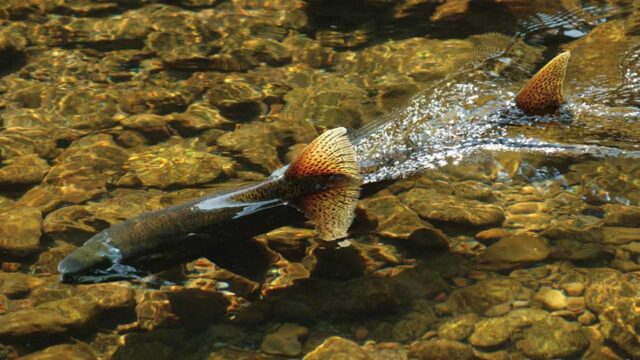Wild salmon are an integral part of the Pacific Northwest — so much so that some First Nations peoples on the West Coast call themselves “salmon people,” and the Wild Salmon Center calls the fish “the biological foundation” of river ecosystems.
Beyond this, wild salmon are also fascinating.
From Sept. 10 to Sept. 14, Ecojustice lawyers will appear in Federal Court on behalf of independent biologist Alexandra Morton to fight to protect wild salmon from a harmful virus called Piscine orthoreovirus, or PRV.
A recent peer reviewed study — co-authored by Department of Fisheries and Oceans scientists, no less — showed that PRV can enter blood cells in Chinook salmon and ultimately cause them to burst, a condition that can result in liver and kidney damage, anemia, and even death.
This unacceptable risk to wild salmon is the source of our opposition to the Minister of Fisheries and Oceans’ risky policy of transferring farmed salmon into open-net pens along wild salmon migration routes without screening for PRV infection.
As we gear up for a court battle over the health of wild salmon, we wanted to share some “wild” facts about this remarkable species. I hope they inspire you to learn more about threats to Pacific wild salmon, to follow along with our upcoming case, and, perhaps, to take action to protect these fish.
Five (ish) species of Pacific salmon live off the coast of British Columbia
Chinook, Coho, Pink, Sockeye and Chum salmon are probably the best-known species of Pacific salmon found off the coast of British Columbia — but Steelhead trout (also called Steelhead salmon) can also be categorized as Pacific salmon because it’s so closely related to them.
The Pacific Salmon Foundation also lists Cutthroat trout as a seventh wild salmon found in B.C.
The smallest wild salmon found off the B.C. coast is the Pink salmon, which can weigh from three to 11 pounds and measure 46 to 61 centimetres long, according to the foundation. Meanwhile Chinook, the largest of the species, tend to weigh about 30 pounds and adults can range from a metre to 1.5 metres in length.
Despite the differences in size, both Pink and Chinook salmon have the same amount of scales.
More than 100 species feed on wild salmon
Orcas, grizzlies, eagles, and at least 134 other species feed on wild salmon, and this, in turn, helps nourish entire ecosystems.
Tom Reimchen, a researcher who studies West Coast ecosystems, found that salmon are intimately connected with the rivers and forests that surround them — impacting species beyond those that directly eat them.
An article in Hakai Magazine describes Reimchen’s findings that bears “ferry” huge numbers of salmon into the forest, where the remains of the fish decay into fertilizer. “Up to 50 per cent of the total nitrogen the trees use comes from salmon,” the article states.
Chinook salmon are also the preferred choice of prey for endangered Southern Resident killer whales. In fact, a single orca can eat up to 25 kilograms of salmon a day. But a drop in Chinook salmon is putting the Southern Residents at serious risk of malnutrition and starvation.
And, of course, salmon are a key source of food for people.
Salmon are a central part of the diet and culture of many First Nations in the Pacific Northwest. As Ernest Alfred, hereditary chief of the Lawit’sis and Mamalilikala Nations, said, “Our salmon is within our DNA.”
Pacific wild salmon are “anadromous.” That means they live in both freshwater and salt water over the source of their lives.
Part of what makes wild salmon so unique is the incredible journey they embark on over the course of their lives.
Pacific wild salmon are born in freshwater streams and rivers. With the exception of Steelhead and Cutthroat, which mostly live in freshwater, the salmon travel to the ocean to spend most of their adulthood. They then return to the streams of their birth to spawn.
Scientists think salmon get their superb navigation skills from their sense of smell. Pacific salmon are able to smell chemicals down to one part per million, the Pacific Salmon Foundation says, and may find their way back to their natal streams by following pheromones.
For most Pacific wild salmon, spawning is their final act. This means they are also “semelparous,” a term for organisms that die after reproducing.
There was once a “saber-toothed salmon”
Fossils from up to 7 million years ago show the presence of the earliest-known salmon in North America, the “Saber-tooth salmon.”
Saber-toothed salmon could measure up to three metres long — double the length of the modern-day Chinook.
How salmon got their name
The image of a salmon swimming upstream is a universal symbol of perseverance — but did you know that salmon may have earned their moniker from this ability?
According to our friends at WWF-Canada, many people believe salmon comes from the Latin word for “to leap”: salmo, or salmire.
We’re headed to court to protect wild salmon
Since launching our case with Alex back in 2016, we’ve also had to persevere — and we couldn’t have done it without supporters like you. Thank you.
As we prepare for our September court date, I invite you to send a special message of support to Alex and our Ecojustice lawyers.
Just hit the button below to wish them luck with the hearing, thank them for the hours they’ve dedicated to protecting this iconic species, or tell them why you believe it’s important to protect wild salmon.



